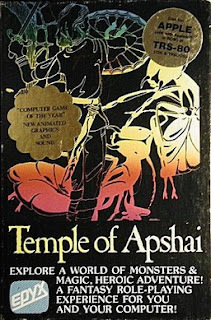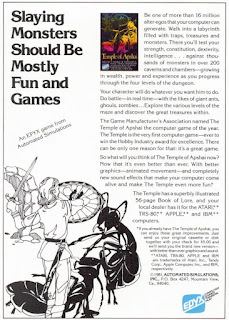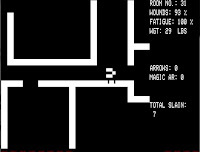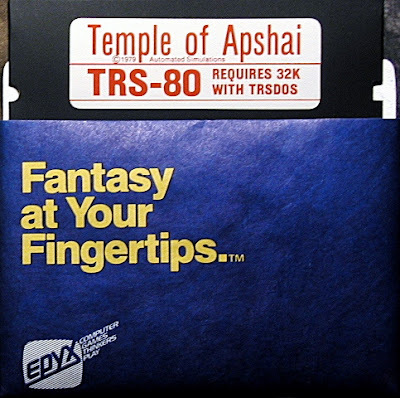Retrospective: Temple of Apshai
 When I was in the seventh grade, a new kid joined my class and he soon became my best friend. He was also an early adopter of personal computers, owning a TRS-80. I didn't own a computer of any kind – and wouldn't until the early '90s – so I spent a lot of time over his house. admiring this wonder of the dawning Information Age. We played a lot of games on that "Trash-80," most of them not very good or memorable. However, a handful do stick out in my mind as being both, chief among them being Temple of Apshai.
When I was in the seventh grade, a new kid joined my class and he soon became my best friend. He was also an early adopter of personal computers, owning a TRS-80. I didn't own a computer of any kind – and wouldn't until the early '90s – so I spent a lot of time over his house. admiring this wonder of the dawning Information Age. We played a lot of games on that "Trash-80," most of them not very good or memorable. However, a handful do stick out in my mind as being both, chief among them being Temple of Apshai.
Temple of Apshai is one of the earliest computer dungeoncrawlers, not to mention one of the first have graphics, albeit very primitive graphics. For many computer aficionados at the time, I suspect that was one of the biggest draws about the game. For me, though, the mere existence of a computer RPG at all was more than enough to attract my attention. That I'd also seen advertisements for Temple of Apshai in the pages of Dragon probably played a role, too. In those days, I was easily captivated by ads and those Dragon magazine ads, showing an adventurer fighting some antmen, intrigued me.
 Temple of Apshai was developed and published by Epyx, the company that also produced Crush, Crumble & Chomp (another game I'd first seen advertised in Dragon). Its earliest version appeared in 1979 and, from what I understand, came on a cassette type, a format that prevented player progress from being saved. My friend and I were playing on a later version that included 5¼-inch floppy disks, thank goodness. Temple of Apshai was already difficult enough as it is. I can't imagine trying to play it without the ability to save.
Temple of Apshai was developed and published by Epyx, the company that also produced Crush, Crumble & Chomp (another game I'd first seen advertised in Dragon). Its earliest version appeared in 1979 and, from what I understand, came on a cassette type, a format that prevented player progress from being saved. My friend and I were playing on a later version that included 5¼-inch floppy disks, thank goodness. Temple of Apshai was already difficult enough as it is. I can't imagine trying to play it without the ability to save.The game's premise is simple: enter and explore the ruined Temple of Apshai, the insect god, in the hopes of finding treasure and magic items. The instruction manual does provide some cursory background information about the founding of the temple and its relationship to the Temple of Geb, the god of earth. But the play of the game doesn't really make use of, let alone depend upon, this information, which is mostly about exploring – and surviving – a four-level dungeon consisting of more than 200 rooms and inhabited by two dozen different types of monsters, most of which are (appropriately) giant insects, along with a handful of slimes and undead.
 As I said above, the game's graphics were quite primitive, not much better than Atari's Adventure, which appeared only a little later. Even so, I was quite impressed with being able to see the layout of the dungeon rooms and corridors, in contrast to games like Zork, which relied entirely on text to present their in-game environments. The limitations of technology at the time being what they were, your character and the dangers he faces appear as simple pixelated shapes rather than as something genuinely representational. Later versions of the game improved upon this, but that occurred long after my friend and I played the game.
As I said above, the game's graphics were quite primitive, not much better than Atari's Adventure, which appeared only a little later. Even so, I was quite impressed with being able to see the layout of the dungeon rooms and corridors, in contrast to games like Zork, which relied entirely on text to present their in-game environments. The limitations of technology at the time being what they were, your character and the dangers he faces appear as simple pixelated shapes rather than as something genuinely representational. Later versions of the game improved upon this, but that occurred long after my friend and I played the game.Like all early computer games, Temple of Apshai clearly shows inspiration from Dungeons & Dragons, but it has a number of features that remind me a bit of RuneQuest . A character had six ability scores – Strength, Constitution, Dexterity, Intelligence, Intuition, and Ego – whose scores ranged from 3 to 18, just as in D&D. However, unlike D&D, there are no character classes. All characters are effectively fighters, since, aside from magic items, no magic powers or spells exist in the game. Further, combat and other actions can fatigue a character, who must rest in order to regain his energy. Armor lessens damage suffered, while shields make a character harder to hit. None of this is remarkable to old RPG hands, but, for a computer game of this, it's pretty sophisticated stuff.
Because of its graphical limitations, Temple of Apshai could not visually distinguish the contents of one room from another. Instead, each room, trap, and treasure have an entry in the game's instruction manual to which the player must refer in order to get a more detailed description of what his character is presumably encountering. For example, the first room of the dungeon is described as follows:
The smooth stonework of the passageway floor shows that advanced methods were used in its creation. A skeleton sprawls on the floor just inside the door, a bony hand still clutching a rusty dagger, outstretched toward the door to safety. A faint roaring sound can be heard from the far end of the passage.
This is very much like a "real" dungeon, which is to say, one a referee might create beforehand, with keyed room descriptions to which he'd refer in play. I don't think I appreciated this at the time, but, in retrospect, I find it fascinating. I recall reading somewhere that Temple of Apshai's designer, Jon Freeman, was inspired to create the game after he'd spent several years trying to find ways to use computers to aid referees in running D&D campaigns. If true, it's yet another reminder of just how important and influential Dungeons & Dragons has been on the growth and development of computer games and, by extension, computer technology itself.
Like so many early computer RPGs, I don't think I could play Temple of Apshai today. That's no knock against the game itself or its deserved place of honor in the history of computer games. Rather, it's because you can't go home again, however much you might want to do so. What enthralled and amazed my friend and I in 1982 is not something that would do so today – but it was an amazing game in its day and I'm glad to have had the chance to play it.

James Maliszewski's Blog
- James Maliszewski's profile
- 3 followers



